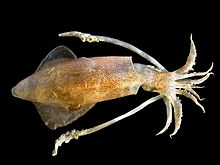SQUID
| Squid Temporal range: (at least) Late Cretaceous–Recent |
|
|---|---|
 |
|
| European squid (Loligo vulgaris) | |
| Scientific classification | |
| Kingdom: | Animalia |
| Phylum: | Mollusca |
| Class: | Cephalopoda |
| Superorder: | Decapodiformes |
| Order: |
Teuthida A. Naef, 1916 |
| Suborders | |
†Plesioteuthididae (incertae sedis)
Myopsina
Oegopsina
Squid are cephalopods of the order Teuthida, which comprises around 304 species. Like all other cephalopods, squid have a distinct head, bilateral symmetry, a mantle, and arms. Squid, like cuttlefish, have eight arms arranged in pairs and two, usually longer, tentacles. Squid are strong swimmers and certain species can "fly" for short distances out of the water.
Squid are members of the class Cephalopoda, subclass Coleoidea, order Teuthida, which has two major suborders, Myopsina and Oegopsina (including giant squid such as Architeuthis dux). Teuthida is the largest cephalopod order with around 300 species classified into 29 families.
The order Teuthida is a member of the superorder Decapodiformes (from the Greek for "ten legs"). Two other orders of decapodiform cephalopods are also called squid, although they are taxonomically distinct from Teuthida and differ recognizably in their gross anatomical features. They are the bobtail squid of order Sepiolida and the ram's horn squid of the monotypic order Spirulida. The vampire squid, however, is more closely related to the octopuses than to any squid.
...
Wikipedia
